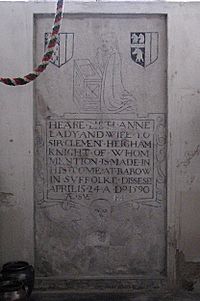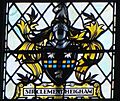Clement Higham facts for kids
Quick facts for kids
Sir Clement Higham
|
|
|---|---|

Heigham's coat of arms, at Lincoln's Inn.
|
|
| Lord Chief Baron of the Exchequer | |
| In office 1558–1559 |
|
| Speaker of the House of Commons | |
| In office 1554–1555 |
|
| Personal details | |
| Born | ca 1495 |
| Died | 9 March 1571 Barrow, Suffolk |
| Spouses | (1) Anne Moonines; (2) Anne Waldegrave (1506–1590) |
| Parents | Clement Heigham; Maud Cooke |
| Alma mater | Lincoln's Inn |
Sir Clement Heigham (born before 1495 – died March 9, 1571) was an important English lawyer and politician from Barrow, Suffolk. He served as the Speaker of the House of Commons in 1554. He also held the high position of Chief Baron of the Exchequer from 1558 to 1559. Sir Clement was a strong supporter of the Roman Catholic faith. He held many important jobs under Queen Mary I and was knighted by King Philip in 1555. After Queen Elizabeth I became queen in 1558, he stepped back from political life.
Contents
Early Life and Law Career
Clement Heigham was born in Suffolk, England, sometime before 1495. His father, also named Clement Heigham, was from Lavenham, Suffolk. His mother was Matilda (Maud) Cooke. We don't know his exact birth date, but he was the oldest of five sons. His father passed away in 1500.
Clement likely studied with monks in Bury St Edmunds Abbey. In 1517, he joined Lincoln's Inn, which was a famous place for training lawyers. He became a lawyer in 1525. Around 1520, he married Anne Monnynge. They had five daughters and one son who died as a baby.
After Anne passed away, Clement married Anne Bures, who was a widow. She was the daughter of George Waldegrave. With Anne, he had three more sons and two daughters. Anne also had four daughters from her first marriage, who became Clement's stepdaughters.
By 1528, Clement was working as a Bailiff for the Bury St Edmunds Abbey. A bailiff managed the abbey's lands and legal matters. In 1529, he became a justice of the peace for Suffolk. This meant he helped keep law and order in the area. He continued in this role for the rest of his life. He also held important positions at Lincoln's Inn, like Pensioner and Keeper of the Black Book. During this time, many monasteries, including Bury Abbey, were closed down by the King.
Life During the Tudor Reigns
After the monasteries closed, Clement Heigham continued to be a trusted lawyer. In 1540, he bought the manor of Barrow, near Chevington. A manor was a large estate with land and buildings. He built his home, Barrow Hall, there. This house stayed in his family for over 200 years. He also bought the manor of Semer from the King in 1543.
In 1544, Queen Katheryn wrote a letter about Clement Heigham. She mentioned that he was chosen by the King's council to help move a large sum of money for the King. This shows how much the royal family trusted him.
After King Henry VIII died and Edward VI became king in 1547, Clement Heigham continued to be important. He became a Governor of Lincoln's Inn. During the 1540s, his stepdaughters married into the Butts family, who were well-known.
In 1552, Clement Heigham was part of a group of commissioners. Their job was to investigate problems with pensions given to former monks and nuns after the monasteries closed.
Serving Queen Mary I
When Queen Mary I came to power in 1553, Clement Heigham quickly showed his loyalty. He was among the first to join her in Norfolk. This loyalty was remembered and rewarded.
In October 1553, he became a Member of Parliament for Rye. He helped with important laws. In April 1554, he became an MP for Ipswich. Soon after, he joined the Privy Council, which was a group of advisors to the monarch.
Speaker of the House of Commons
In November 1554, after Queen Mary married King Philip, Clement Heigham was chosen as the Speaker of the House of Commons. This was a very important role. The Speaker leads the discussions in Parliament.
During this time, Parliament discussed important religious changes. The goal was to bring back the Catholic religion. Clement Heigham led these discussions. He was knighted by King Philip in January 1555 for his service.
Religious Cases
As a judge and magistrate, Sir Clement Heigham was involved in many legal cases, including those related to religion. During Queen Mary's reign, there were strict laws about religious beliefs. People who did not follow the official Catholic religion were sometimes brought to court.
Sir Clement was present at important hearings. For example, he was a witness when Bishop John Hooper was questioned about his religious views. He also heard cases involving people like Thomas Mountain and Robert Pygot, who had different religious opinions.
In Ipswich, he was involved in the cases of Agnes Potten and Joan Trunchfield, two women who were arrested for their beliefs. He also questioned John Fortune, a blacksmith, about his views. These cases show his role in upholding the laws of the time, which included enforcing religious conformity.
Heigham was also involved in the case of John Cooper, who was accused of saying treasonous things about the Queen. Sir Clement was known for being firm in these matters.
Chief Baron of the Exchequer
In March 1558, Sir Clement Heigham was appointed Chief Baron of the Exchequer. This was a very high legal position, even though he had not held the rank of Serjeant-at-law. He was responsible for legal matters related to the royal treasury.
He was involved in a major case concerning the loss of Calais to the French. Several important officials were accused of treason for their role in this event. Sir Clement helped investigate their actions.
Later Years Under Queen Elizabeth I
When Queen Elizabeth I became queen in 1558, Sir Clement Heigham was reappointed as Chief Baron of the Exchequer. However, he resigned from this role in January 1559. Queen Elizabeth's government had different religious policies than Queen Mary's. Because of his strong Catholic beliefs, Sir Clement decided to retire from public office and returned to Barrow Hall.
Even in retirement, he remained a justice of the peace in Suffolk. He was known for helping his neighbors settle their disagreements peacefully. He also kept his role as Chief Bailiff for the town of Bury St Edmunds. He had a long friendship with Sir Nicholas Bacon, who became Lord Keeper to Queen Elizabeth. They worked together on local matters, like trying to get a special charter for Bury St Edmunds.
Sir Clement Heigham made his will in November 1570. In it, he expressed his strong Catholic faith. He also left gifts to the poor people living on his estates. He passed away on March 9, 1571, and was buried in Barrow, Suffolk.
Family Life
Sir Clement Heigham was married twice and had many children.
His first wife was Anne Moonines. They had one son who died young, and five daughters:
- Elizabeth Heigham
- Margaret Heigham
- Anne Heigham
- Frances Heigham
- Lucy Heigham
His second wife was Anne Waldegrave (1506–1590). She was a widow when they married. Anne was the daughter of Sir George Waldegrave. With Anne, Sir Clement had several more children, including:
- Sir John Heigham, his oldest son and heir, who became a Member of Parliament for Ipswich.
- Thomas Heigham
- William Heigham
- Judith Heigham
- Dorothy Heigham
His Tomb
Sir Clement Heigham is buried in the Church of All Saints in Barrow, Suffolk. His tomb is against the south wall of the church. It has a stone chest with a low, arched roof above it. The tomb is decorated with carved patterns and shields.
Inside the tomb, there is a brass memorial. It has a long poem about Sir Clement. There are also brass figures. Sir Clement is shown kneeling in prayer, wearing armor. He faces his second wife, Anne Waldegrave, who is also kneeling, with their two daughters behind her.
On the other side, his first wife, Anne Munnings, is shown kneeling with their five daughters behind her. A small figure of a baby represents his son who died young. Above these figures are three shields with family symbols, called heraldry. These symbols show the Heigham family crest and the families he married into.
Images for kids




